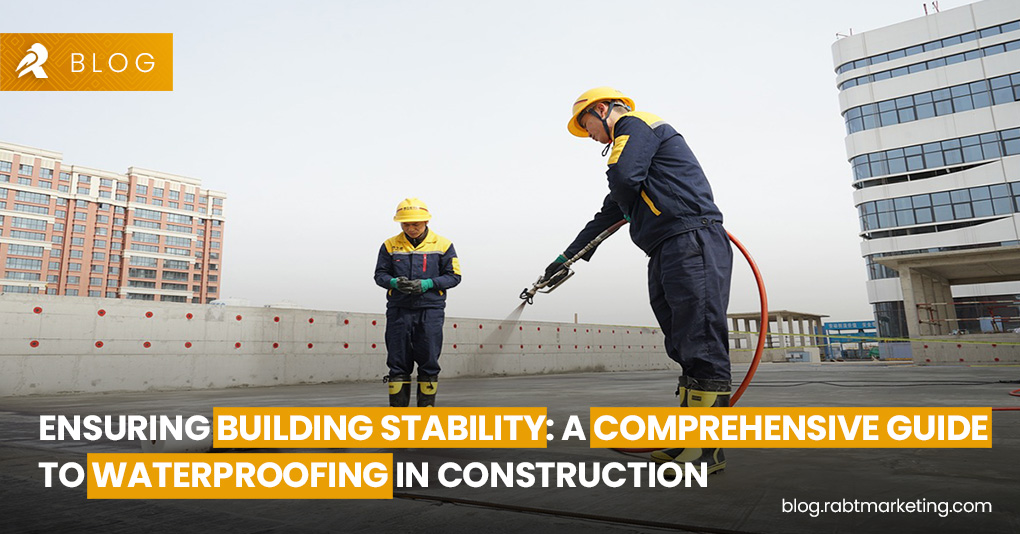Structural Stability of building is one of the most considerable factor in construction industry. Constructing a building without evaluating its structural stability is just wasting a huge amount of investment. Structural engineers have developed multiple ways toensure the durability of structures. Structural engineering is a complete branch of civil engineering that primarily deals with the strength of structres constructed. Few of these methods are following
- Guniting
- Shortcreting
- Underpinning
- Shoring
- Underpinning
- Waterproofing
In this blog,we will put light on the importance of waterproofing,its pros and cons and and types as well.
What is Waterproofing ?
Waterproofing is basically the process of making an object or structure resistant to water penetration. Waterproofing as its name implies, it is the process to prevent liquid entrance in any structure. It’s like an invisible shield that protects against leaks, dampness, and the damaging effects of moisture. You can consider it as a raincoat for your building as well.
Importance of Waterproofing in Building Construction
In construction industry, waterproofing stands as the one of the finest method for the longevity and lastingness of buildings. Especially in the countries like Pakistan in which buildings are inevitably exposed to harsh weather conditions. Waterproofing not only upholds the building’s integrity but also enhances its durability by preventing water intrusion into its components.
Advantages of Water Proofing
Long-Term Cost Savings
Waterproofing helps to prevent structural damage, which can lead to costly repairs and replacements. Hence waterproofing is a long-term cost savings
Improved Property Durability
Waterproofed buildings can bear the wear and tear of extreme weather conditions and enhances the durability of buildings.
Reduced Risk of Erosion
Waterproofing also reduces the risk of structural erosions.Furthermore, it also helps to protect the occupants of the building from potential water damage.
Prevents growth
Damp environments are breeding grounds for mold and mildew, which can cause health problems and respiratory issues. Waterproofing keeps these harmful organisms away
Improves energy efficiency
Leaks and drafts can lead to higher energy bills. Waterproofing seals up the building envelope, making it more airtight and energy-efficient.
Healthy Environment
A dry and mold-free environment is more comfortable and healthy to live in. Waterproofing contributes to a better quality of life for occupants.
Increases property value
A well-waterproofed property is more valuable and attractive to potential buyers.
Types/Methods of Waterproofing in Construction
Various methods exist for waterproofing, each catering to specific needs and conditions. The following are five prevalent types/methods/techniques of waterproofing in construction:
Bituminous Coating
This type of waterproofing consists of bitumen-based materials. Bituminous coating forms a flexible protective layer widely used beneath wet screeds and on concrete foundation surfaces.
Membrane waterproofing
This involves applying a flexible sheet-like material to the surface, such as PVC, asphalt, or rubber. It’s ideal for roofs, foundations, and wet areas like bathrooms.
Cementitious Waterproofing
In this type, cement-based polymer coatings are applied. It is an easy and cost-effective method, cementitious waterproofing forms a flexible layer a top damaged buildings, commonly used in structures like dams, bridges, tunnels, and parking facilities.
Polyurethane Liquid Membrane
Although expensive, this technique is favored for its ease of use, quick application post-construction, durability, and aesthetically pleasing finish.
Liquid Waterproofing Membrane
This involves applying a paint-like coating to the surface, such as acrylic, polyurethane, or epoxy. It’s suitable for walls, floors, and tanks, kitchens and roofing. This method offers thin consistency and increased flexibility compared to cementitious types.
Application Areas of Waterproofing
Practical applications of waterproofing in construction and building phases are diverse and essential for a structure’s survival. Key application areas include:
- Roofs and Terraces
- Basements and Foundation Walls
- Bathrooms and Wet Areas
- Swimming Pools and Water Tanks
Disadantages of Water Proofing
Despite its advantages, waterproofing may not be suitable for every construction project, with potential drawbacks including:
Initial cost
Applying waterproofing can be costly, depending on the material, size, and complexity of the project.
Maintenance
Some waterproofing materials require regular maintenance or reapplication to maintain their effectiveness.
Environmental impact
Certain waterproofing materials may contain harmful chemicals or have a high embodied energy. Choose eco-friendly options whenever possible.
Short Life-span
In summer, short lifespan of bitumen based products can be strong disadvantage of waterproofing.
Further more some other advantages are also
- Limited Adaptability of Polyurethane Membranes.
- Impaired Natural Breathing of Concrete in Polyurethane Coatings.
- Inability to Manage Fractures in Cementitious Waterproofing.
Read More:- What is Underpinning? How to Repair and Fix a Building
Read More:- Real Estate Revolution on Mars Planet: Space Colonization
Frequently Asked Questions (FAQs)
Q. What is the waterproofing procedure?
Ans. The waterproofing procedure involves creating a barrier on surfaces of foundations, roofs, walls, and other structural members to prevent water infiltrations.
Q. What is the purpose of the waterproofing system?
Ans. The aim is to prevent water intrusion, avoiding unhealthy conditions, loss of amenities, and dampness in building elements.
Q. What are the types of waterproofing methods?
Ans. 5 types of waterproofing method includes Bituminous Coating, Bituminous Membrane, Cementitious Waterproofing, Polyurethane Liquid Membrane, and Liquid Waterproofing Membrane.
Q. Which method of waterproofing is most expensive?
Ans. Polyurethane Liquid Membrane is the most expensive method.
Q. Does water penetration damage the structure?
Yes, water penetration can cause damage to foundations, roofs, bathrooms, kitchens, etc.
Q. Where can waterproofing be used in the building?
Waterproofing can be applied on roofs, kitchens, floors, bathrooms, ceilings, etc.
Conclusion
Concluding the discussion, waterproofing play a significant role in enhancing a building’s lifespan by offering resistance against liquids and moisture.This is a good technology for long-term benefits of building. Hence it is better to invest money in making the buildings waterproofed to avoid any kind of future damage..

